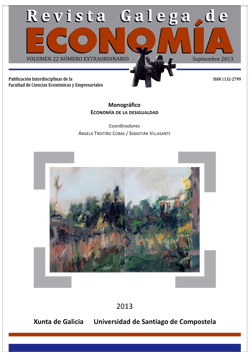Mercado de trabajo, formación y exclusión social: análisis de la situación de la población reclusa de Galicia
Contenido principal del artículo
Resumen
Palabras clave:
Detalles del artículo
Referencias
ATKINSON, A. B. (1998): “Social Exclusion, Poverty and Unemployment”, en J. Hills [ed.]: Exclusion, Employment and Opportunity, pp. 1-20. London: London School of Economics and Political Science, Centre for Analysis of Social Exclusion (CASE).
BALES, W.D.; MEARS, D.P. (2008): “Inmate Social Ties and the Transition to Society. Does Visitation Reduce Recidivism?”, Journal of Research in Crime and Delinquency, 45 (3), pp. 287-321.
BARREIRO GEN, M. (2012): “La inclusión sociolaboral de la población reclusa de Galicia: principales obstáculos y propuestas para su superación”, Atlantic Review of Economics, (1). <http://www.unagaliciamoderna.com/eawp/eawp.asp?qsa=ES&qsb=253&qsc=277&qsd=282>.
COCHRAN, J.C. (2012): “The Ties that Bind or the Ties that Break: Examining the Relationship between Visitation and Prisoner Misconduct”, Journal of Criminal Justice, 40 (5), pp. 433-440.
COMISIÓN EUROPEA (2010): Comunicación de la Comisión, de 3 de marzo de 2010, denominada «Europa 2020. Una estrategia para un crecimiento inteligente, sostenible e integrador». [COM (2010) 2020, de 03/03/10]. Bruselas: Comisión Europea.
COMMINS, P. [ed.] (1993): Combatting Exclusion in Ireland, 1990-94: A Midway Report. Brussels: European Commission.
CONSEJO EUROPEO (2000): Directrices del Consejo Europeo de 2000. Bruselas: Consejo Europeo.
DE ALÓS-MONER VILA, R.; ESTEBAN, F.; JÓDAR MARTÍNEZ, P.; MIGUÉLEZ LOBO, F.; ALCAIDE LOZANO, V.; LÓPEZ ROLDÁN, P. (2011): La inserción laboral de los ex internos de los centros penitenciarios de Cataluña. Barcelona: Generalitat de Cataluña, Centro de Estudios Jurídicos y Formación Especializada.
DE OLIVEIRA LUSSI, I.A.; ORNELLAS PEREIRA, M.A. (2011): “Social Companies and Solidary Economy: Perspectives for the Work Inclusion of Individuals with Mental Disorders”, Revista da Escola de Enfermagem da USP, 45 (2), pp. 503-509.
DEMING, D. (2011): “Betters Schools, Less Crime?” The Quarterly Journal of Economics, 126, pp. 2063-2115.
ENTORF, H. (2009): “Crime and the Labour Market: Evidence from a Survey of Inmates”, Jahrbucher Fur Nationalokonomie Und Statistik, 229 (2-3), pp. 254-269.
ESPAÑA. MINISTERIO DEL INTERIOR (2009): Anuario Estadístico del Ministerio del Interior 2009, cap. 4. Madrid: Ministerio del Interior.
ESPAÑA. MINISTERIO DEL INTERIOR (2010): Sistema penitenciario español. Madrid: Ministerio del Interior. <http://www.institucionpenitenciaria.es/web/export/sites/default/datos/descargables/publicaciones/El_sistema_penitenciario_espanol.pdf>.
GALLIE, D.; PAUGAM, S.; JACOBS, S. (2003): “Unemployment, Poverty and Social Isolation - Is there a Vicious Circle of Social Exclusion?”, European Societies, 5 (1), pp. 1-32.
HAUGHTON, J.; KHANDKER, S.R. (2009): Handbook on Poverty and Inequality. Washington D.C., WA: The World Bank.
HUEBNER, B.M.; DEJONG, C.; COBBINA, J. (2010): “Women Coming Home: Long-Term Patterns of Recidivism”, Justice Quarterly, 27 (2), pp. 225-254.
INSTITUTO NACIONAL DE ESTADÍSTICA (2012): Encuesta sobre condiciones de vida. Resultados provisionales. <http://www.ine.es/jaxi/menu.do?type=pcaxis&path=/t25/p453&file=inebase>.
LIEBLING, A.; ARNOLD, H. (2012): “Social Relationships between Prisoners in a Maximum Security Prison: Violence, Faith, and the Declining Nature of Trust”, Journal of Criminal Justice, 40 (5), pp. 413-424.
NACIONES UNIDAS (2000): Declaración del Milenio. (A/RES/55/2*). (Distr. general 13 de septiembre de 2000). New York, NY: Naciones Unidas, Asamblea General.
NARAINE, M.D.; LINDSAY, P.H. (2011): “Social Inclusion of Employees who Are Blind or Low Vision”, Disability & Society, 26 (4), pp. 389-403.
NOVO CORTI, I.; RAMIL DÍAZ, M.; BARREIRO GEN, M. (2011): “Does EU Membership Affect the Social and Labour Inclusion of Foreign Prisoners in Spain? An Analysis of Self-Perceptions and Attitudes Towards Learning”, The Annals of the Stefan cel Mare University of Suceava, 11, 2 (14), pp. 7-15.
OPSAL, T. (2012): “'Livin’ on the Straights: Identity, Desistance, and Work among Women Post-Incarceration”, Sociological Inquiry, 82 (3), pp. 378-403.
ROOM, G. (1995): “Poverty and Social Exclusion: The New European Agenda for Policy and Research”, en G. Room [ed.]: Beyond the Threshold, pp. 1-9. Bristol: Policy Press.
SEN, A. (1992): “Sobre conceptos y medidas de pobreza”, Comercio Exterior, 42 (2), pp. 310-322.
SEN, A. (2000): Social Exclusion: Concept. Application and Scrutiny. (Social Development Papers, 1). Manila: Asian Development Bank, Office of Environment and Social Development.
SEVERANCE, T.A. (2005): “You Know who you can go to: Cooperation and Exchange between Incarcerated Women”, Prison Journal, 85 (3), pp. 343-367.
SMEROTKINA, K. (2010): “Education as a Prerequisite for Inclusion of Prisoners in the Society”, International Scientific Conference on Society, Integration, and Education. Rezekne.
ŠPADIJER-DŽINIĆ, J.; PAVIĆEVIĆ, O.; SIMEUNOVIĆ-PATIĆ, B. (2009): “Women in Prison: Deprivations of Prison Life. [Žena u zatvoru - Deprivacije zatvoreničkog života]”, Sociologija, 51 (3), pp. 225-246.
SUBIRATS, J. [dir.]; RIBA, C.; GIMÉNEZ, L.; OBRADORS, A.; GIMÉNEZ M.; QUERALT, D.; BOTTOS, P.; RAPOPORT, A. (2004): Pobreza y exclusión social. Un análisis de la realidad española y europea. Barcelona: Fundación La Caixa. <http://obrasocial.lacaixa.es/StaticFiles/StaticFiles/a84f7102892ef010VgnVCM1000000e8cf10aRCRD/es/es16_esp.pdf>.
VILA MERINO, E.S. (2011): “Políticas educativas globales en clave de derechos: un análisis desde la equidad y el reconocimiento”, Qurriculum: Revista de Teoría, Investigación y Práctica Educativa, 24, pp. 29-40






